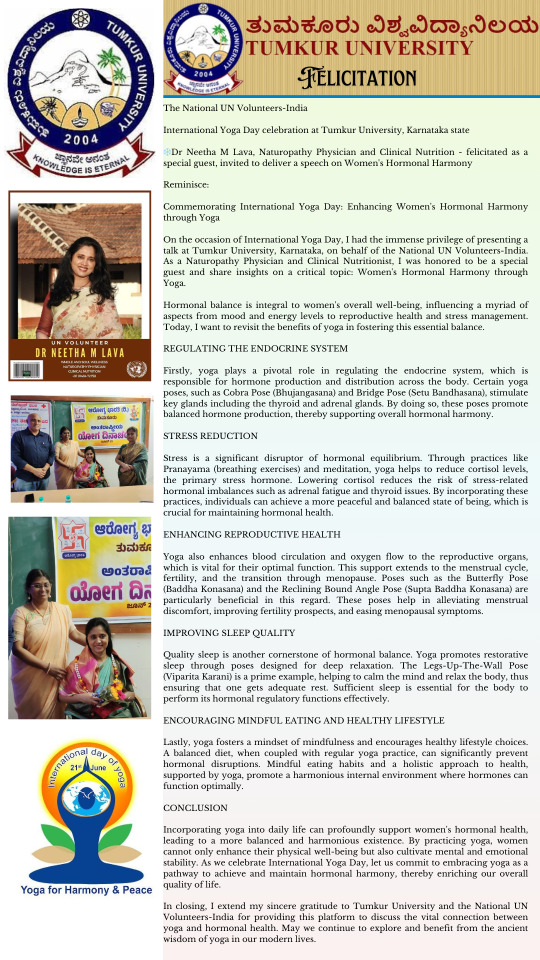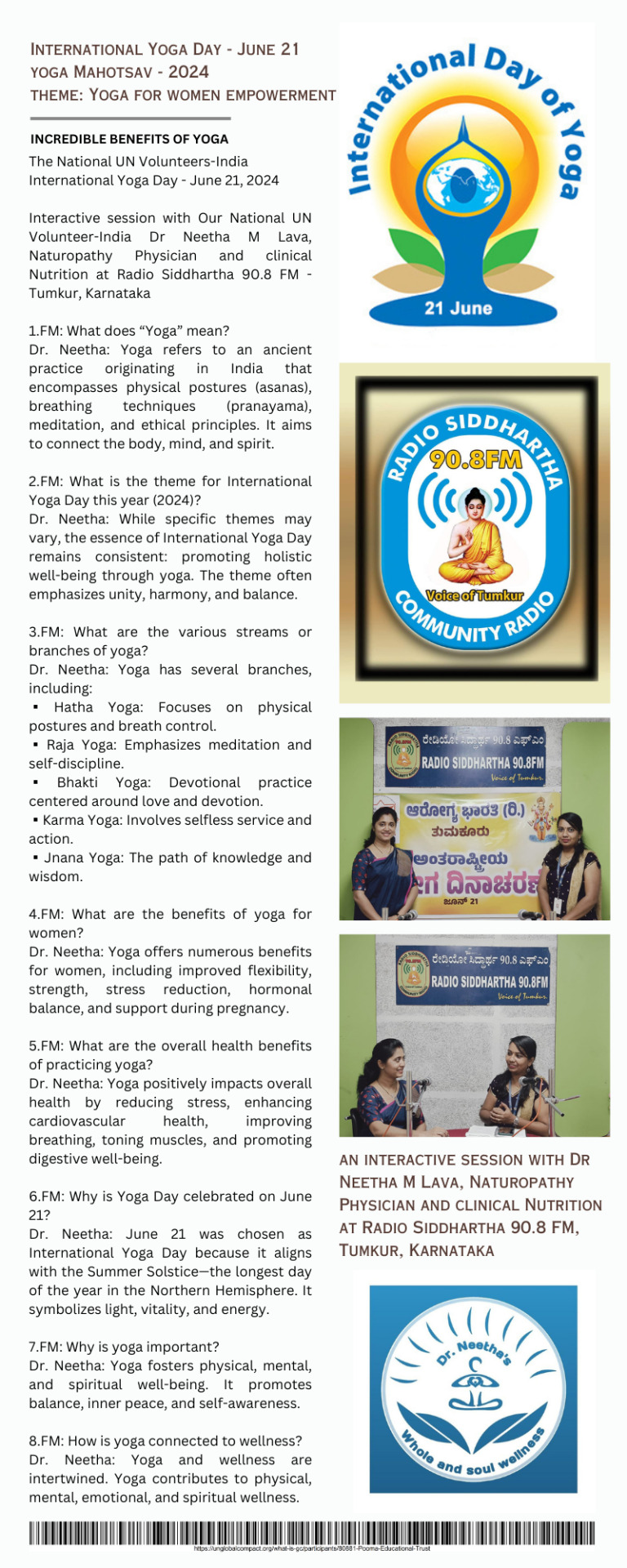Naturopathy Physician and Clinical Nutrition
Last active 3 hours ago
Don't wanna be here? Send us removal request.
Text
The National UN Volunteers-India
International Yoga Day celebration at Tumkur University, Karnataka state
❄️Dr Neetha M Lava, Naturopathy Physician and Clinical Nutrition - felicitated as a special guest, invited to deliver a speech on Women's Hormonal Harmony
Reminisce:
Commemorating International Yoga Day: Enhancing Women's Hormonal Harmony through Yoga
On the occasion of International Yoga Day, I had the immense privilege of presenting a talk at Tumkur University, Karnataka, on behalf of the National UN Volunteers-India. As a Naturopathy Physician and Clinical Nutritionist, I was honored to be a special guest and share insights on a critical topic: Women's Hormonal Harmony through Yoga.
Hormonal balance is integral to women's overall well-being, influencing a myriad of aspects from mood and energy levels to reproductive health and stress management. Today, I want to revisit the benefits of yoga in fostering this essential balance.
REGULATING THE ENDOCRINE SYSTEM
Firstly, yoga plays a pivotal role in regulating the endocrine system, which is responsible for hormone production and distribution across the body. Certain yoga poses, such as Cobra Pose (Bhujangasana) and Bridge Pose (Setu Bandhasana), stimulate key glands including the thyroid and adrenal glands. By doing so, these poses promote balanced hormone production, thereby supporting overall hormonal harmony.
STRESS REDUCTION
Stress is a significant disruptor of hormonal equilibrium. Through practices like Pranayama (breathing exercises) and meditation, yoga helps to reduce cortisol levels, the primary stress hormone. Lowering cortisol reduces the risk of stress-related hormonal imbalances such as adrenal fatigue and thyroid issues. By incorporating these practices, individuals can achieve a more peaceful and balanced state of being, which is crucial for maintaining hormonal health.
ENHANCING REPRODUCTIVE HEALTH
Yoga also enhances blood circulation and oxygen flow to the reproductive organs, which is vital for their optimal function. This support extends to the menstrual cycle, fertility, and the transition through menopause. Poses such as the Butterfly Pose (Baddha Konasana) and the Reclining Bound Angle Pose (Supta Baddha Konasana) are particularly beneficial in this regard. These poses help in alleviating menstrual discomfort, improving fertility prospects, and easing menopausal symptoms.
IMPROVING SLEEP QUALITY
Quality sleep is another cornerstone of hormonal balance. Yoga promotes restorative sleep through poses designed for deep relaxation. The Legs-Up-The-Wall Pose (Viparita Karani) is a prime example, helping to calm the mind and relax the body, thus ensuring that one gets adequate rest. Sufficient sleep is essential for the body to perform its hormonal regulatory functions effectively.
ENCOURAGING MINDFUL EATING AND HEALTHY LIFESTYLE
Lastly, yoga fosters a mindset of mindfulness and encourages healthy lifestyle choices. A balanced diet, when coupled with regular yoga practice, can significantly prevent hormonal disruptions. Mindful eating habits and a holistic approach to health, supported by yoga, promote a harmonious internal environment where hormones can function optimally.
CONCLUSION
Incorporating yoga into daily life can profoundly support women's hormonal health, leading to a more balanced and harmonious existence. By practicing yoga, women cannot only enhance their physical well-being but also cultivate mental and emotional stability. As we celebrate International Yoga Day, let us commit to embracing yoga as a pathway to achieve and maintain hormonal harmony, thereby enriching our overall quality of life.
In closing, I extend my sincere gratitude to Tumkur University and the National UN Volunteers-India for providing this platform to discuss the vital connection between yoga and hormonal health. May we continue to explore and benefit from the ancient wisdom of yoga in our modern lives.

0 notes
Text
The National UN Volunteers-India
International Yoga Day - June 21, 2024
Interactive session with Our National UN Volunteer-India Dr Neetha M Lava, Naturopathy Physician and clinical Nutrition at Radio Siddhartha 90.8 FM - Tumkur, Karnataka
1.FM: What does “Yoga” mean?
Dr. Neetha: Yoga refers to an ancient practice originating in India that encompasses physical postures (asanas), breathing techniques (pranayama), meditation, and ethical principles. It aims to connect the body, mind, and spirit.
2.FM: What is the theme for International Yoga Day this year (2024)?
Dr. Neetha: While specific themes may vary, the essence of International Yoga Day remains consistent: promoting holistic well-being through yoga. The theme often emphasizes unity, harmony, and balance.
3.FM: What are the various streams or branches of yoga?
Dr. Neetha: Yoga has several branches, including:
▪️Hatha Yoga: Focuses on physical postures and breath control.
▪️Raja Yoga: Emphasizes meditation and self-discipline.
▪️Bhakti Yoga: Devotional practice centered around love and devotion.
▪️Karma Yoga: Involves selfless service and action.
▪️Jnana Yoga: The path of knowledge and wisdom.
4.FM: What are the benefits of yoga for women?
Dr. Neetha: Yoga offers numerous benefits for women, including improved flexibility, strength, stress reduction, hormonal balance, and support during pregnancy.
5.FM: What are the overall health benefits of practicing yoga?
Dr. Neetha: Yoga positively impacts overall health by reducing stress, enhancing cardiovascular health, improving breathing, toning muscles, and promoting digestive well-being.
6.FM: Why is Yoga Day celebrated on June 21?
Dr. Neetha: June 21 was chosen as International Yoga Day because it aligns with the Summer Solstice—the longest day of the year in the Northern Hemisphere. It symbolizes light, vitality, and energy.
7.FM: Why is yoga important?
Dr. Neetha: Yoga fosters physical, mental, and spiritual well-being. It promotes balance, inner peace, and self-awareness.
8.FM: How is yoga connected to wellness?
Dr. Neetha: Yoga and wellness are intertwined. Yoga contributes to physical, mental, emotional, and spiritual wellness.

0 notes
Text
Dr Neetha M Lava, Naturopathy Physician and Clinical Nutrition
❄️ DO YOU KNOW WHEN IS YOUR ‘FERTILE WINDOW’?
A woman should know her menstrual cycle as it is only a few days per month a ‘fertile window’ when you could conceive.
The ‘fertile window” depends on the length of the menstrual cycle, which is different for every woman (between 21 to 35 days). The first day of your cycle is the first day of your period.
The menstrual cycle consists of 4 phases:
▪️ MENSTRUATION - is the elimination of the thickened lining of the uterus (endometrium) from the body through the vagina. Menstrual fluid contains blood, cells from the lining of the uterus (endometrial cells) and mucus.
▪️ FOLLICULAR PHASE - The follicular phase starts on the first day of menstruation and ends with ovulation. Prompted by the hypothalamus, the pituitary gland releases follicle stimulating hormone (FSH). This hormone stimulates the ovary to produce around 5 to 20 follicles (tiny nodules or cysts), which bead on the surface. Each follicle houses an immature egg. Usually, only one follicle will mature into an egg, while the others die. This can occur around day 10 of a 28-day cycle. The growth of the follicles stimulates the lining of the uterus to thicken in preparation for possible pregnancy.
▪️OVULATION PHASE - this is a ’fertile window’. During the ovulation a mature egg is released from the surface of the ovary. This usually occurs mid-cycle, around two weeks or so before menstruation starts. During the follicular phase, the developing follicle causes a rise in the level of estrogen. The hypothalamus in the brain recognizes these rising levels and releases a chemical called gonadotrophin-releasing hormone (GnRH). This hormone prompts the pituitary gland to produce raised levels of luteinizing hormone (LH) and FSH. Within two days, ovulation is triggered by the high levels of LH. The egg is funneled into the fallopian tube and toward the uterus by waves of small, hair-like projections. The life span of the typical egg is only around 24 hours. Unless it meets a sperm during this time, it will die.
▪️LUTEAL PHASE - during ovulation, the egg bursts from its follicle, but the ruptured follicle stays on the surface of the ovary. For the next two weeks or so, the follicle transforms into a structure known as the corpus luteum. This structure starts releasing progesterone, along with small amounts of estrogen. This combination of hormones maintains the thickened lining of the uterus, waiting for a fertilized egg to implant. If a fertilized egg implants in the lining of the uterus, it produces the hormones that are necessary to maintain the corpus luteum. This includes human chorionic gonadotrophin (HCG), the hormone that is detected in a urine test for pregnancy. The corpus luteum keeps producing the raised levels of progesterone that are needed to maintain the thickened lining of the uterus. If pregnancy does not occur, the corpus luteum withers and dies, usually around day 22 in a 28-day cycle. The drop in progesterone levels causes the lining of the uterus to fall away. This is known as menstruation. The cycle then repeats.
It is important to have sex during your ‘fertile window’, which is 5-3 days before your ovulation and 12- 24 hours after, but not all the women have regular cycles or doesn’t know when they are ovulating, so it is advisable to have intercourse every 2- 3 days, constantly, till you get pregnant. Why every 2- 3 days, well because the released sperm can survive 2- 5 days in the uterus, so having the sex by this frequency and when the egg will be released, the sperm will be there waiting to fertilize.

0 notes